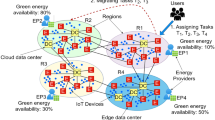Abstract
We present a technique that controls the peak power consumption of a high-density server by implementing a feedback controller that uses precise, system-level power measurement to periodically select the highest performance state while keeping the system within a fixed power constraint. A control theoretic methodology is applied to systematically design this control loop with analytic assurances of system stability and controller performance, despite unpredictable workloads and running environments. In a real server we are able to control power over a 1 second period to within 1 W and over an 8 second period to within 0.1 W.
Conventional servers respond to power supply constraint situations by using simple open-loop policies to set a safe performance level in order to limit peak power consumption. We show that closed-loop control can provide higher performance under these conditions and implement this technique on an IBM BladeCenter HS20 server. Experimental results demonstrate that closed-loop control provides up to 82% higher application performance compared to open-loop control and up to 17% higher performance compared to a widely used ad-hoc technique.
Similar content being viewed by others
References
Lefurgy, C., et al.: Energy management for commercial servers. Computer 36(12) (2004)
Bohrer, P., et al.: The case for power management in web servers. In: Graybill, R., Melhem, R. (eds.) Power Aware Computing. Kluwer, Dordrecht (2002)
Zeng, H., et al.: Ecosystem: managing energy as a first class operating system resource. In: Int. Conf. on Architectural Support for Programming Languages and Operating Systems (2002)
Lu, Y.H., et al.: Operating-system directed power reduction. In: Int. Symp. on Low Power Electronics and Design (2000)
Hellerstein, J., et al.: Feedback Control of Computing Systems. Wiley, New York (2004)
Skadron, K., et al.: Control-theoretic techniques and thermal-RC modeling for accurate and localized dynamic thermal management. In: Proceedings of the Eighth International Symp. on High-Performance Computer Architecture (2002)
Wu, Q., et al.: Formal control techniques for power-performance management. IEEE Micro 25(5), 52–62 (2005)
Minerick, R.J., Freeh, V.W., Kogge, P.M.: Dynamic power management using feedback. In: Proceedings of Workshop on Compilers and Operating Systems for Low Power (COLP) (2002)
Femal, M.E., Freeh, V.W.: Boosting data center performance through non-uniform power allocation. In: Proceedings of 2nd Intl. Conf. on Autonomic Computing (2005)
Sharma, V., et al.: Power-aware QoS management on web servers. In: Proceedings of the 24th International Real-Time Systems Symposium (RTSS), December 2003
Chen, Y., et al.: Managing server energy and operational costs in hosting centers. In: Proceedings of the ACM SIGMETRICS International Conference on Measurement and Modeling of Computer Systems, June 2005
Franklin, G.F., et al.: Digital Control of Dynamic Systems, 3rd edn. Addison-Wesley, Reading (1997)
Intel: Maximum Power Program User Guide Version 2.0 for Nocona/Irwindale Processor (2004)
Brey, T., et al.: BladeCenter chassis management. IBM J. Res. Dev. 49(6) (2005)
Wang, X., Lefurgy, C., Ware, M.: Managing peak system-level power with feedback control. IBM Research Technical Report RC23835 (2005)
Norsworthy, S., Schreier, R., Temes, G. (eds.): Delta-Sigma Data Converters: Theory, Design, and Simulation. Wiley-IEEE Press, New York (1996)
Brooks, D., Martonosi, M.: Dynamic thermal management for high-performance microprocessors. In: Proceedings of the 7th Symp. on High Performance Computer Architecture (HPCA-7) (2001)
Felter, W., et al.: A performance-conserving approach for reducing peak power consumption in server systems. In: Proceedings of the International Conf. on Supercomputing (2005)
Poirier, C., et al.: Power and temperature control on a 90 nm itanium-family processor. In: Proceedings of Intl. Solid State Circuits Conf. (2005)
IBM Systems: IBM PowerExecutive 1.10 Installation and User’s Guide Version 1.10, 2nd edn. (2006)
Intel: Dual-Core Intel Xeon Processor 5100 Series Thermal/Mechanical Design Guide (2006)
Colwell, B.: We may need a new box. Computer, March (2004)
Ranganathan, P., et al.: Ensemble-level power management for dense blade servers. In: Proceedings of the 33rd Annual Intl. Symp. on Computer Architecture (ISCA) (2006)
Lefurgy, C., Wang, X., Ware, M.: Server-level power control. In: 4th IEEE Conference on Autonomic Computing (2007)
Fan, X., Weber, W., Barroso, L.: Power provisioning for a warehouse-sized computer. In: Proceedings of the 34th Annual Intl. Symp. on Computer Architecture (ISCA) (2007)
Author information
Authors and Affiliations
Corresponding author
Rights and permissions
About this article
Cite this article
Lefurgy, C., Wang, X. & Ware, M. Power capping: a prelude to power shifting. Cluster Comput 11, 183–195 (2008). https://doi.org/10.1007/s10586-007-0045-4
Received:
Accepted:
Published:
Issue Date:
DOI: https://doi.org/10.1007/s10586-007-0045-4




